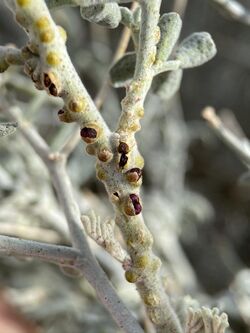Biology:Pilostyles thurberi
| Pilostyles thurberi | |
|---|---|

| |
| The flowers erupting from the stem of another plant | |
| Scientific classification | |
| Kingdom: | Plantae |
| Clade: | Tracheophytes |
| Clade: | Angiosperms |
| Clade: | Eudicots |
| Clade: | Rosids |
| Order: | Cucurbitales |
| Family: | Apodanthaceae |
| Genus: | Pilostyles |
| Species: | P. thurberi
|
| Binomial name | |
| Pilostyles thurberi A.Gray
| |
Pilostyles thurberi is a species of endoparasitic flowering plant known by the common names Thurber's stemsucker[1] and Thurber's pilostyles. It is native to the southwestern United States and northern Mexico, where it grows in desert and woodland. In the United States, P. thurberi has been recorded from the states of Arizona, California , New Mexico, Nevada, Texas .[2][3][4]
Description
It is a tiny parasitic plant, only a few millimeters long, which lives in the stem tissues of its host plants, species of legume shrubs, often of genus Psorothamnus, especially Emory's indigo bush or dyebush (Psorothamnus emoryi). It has no roots, leaves, or chlorophyll, obtaining its water and nutrients from the host.[5] It grows as microscopic strands similar to fungal filaments completely within the stems of its host, until when it blooms, sending tiny flowers through the surface of the host plant.[6]
It is a dioecious species, with male and female individuals producing one type of flower each. Both types are brown or maroon and no more than 2 millimeters across, appearing as specks on the stem of the host plant.[5] The bloom usually occurs in January, but sometimes as early as November.[5] The female flower swells slightly as the fruit capsule develops within, and each may hold over 100 seeds, which are minute.[5]
Taxonomy
The plant was named by the botanist Asa Gray in honor of George Thurber, another botanist who once worked for the United States and Mexican Boundary Survey.[7]
Distribution and habitat
This species is found in both the United States and Mexico. It has been recorded from the states of Arizona, California , New Mexico, Nevada, Texas in the United States.[4] In Mexico, this species is found in the state of Baja California, ranging from Mexicali to San Felipe, and in the states of Sonora and Chihuahua.[8] It occurs primarily in open desert scrub, from 100 to 1000 meters in elevation.[4]
References
- ↑ "Pilostyles thurberi". Natural Resources Conservation Service PLANTS Database. USDA. https://plants.usda.gov/core/profile?symbol=PITH. Retrieved 3 October 2015.
- ↑ Yatskievych, George (1994). "Rafflesiaceae Rafflesia Family". Journal of the Arizona-Nevada Academy of Science 27 (2): 239. ISSN 0193-8509. https://www.jstor.org/stable/40024459.
- ↑ "Pilostyles thurberi". https://ucjeps.berkeley.edu/eflora/eflora_display.php?tid=38231.
- ↑ 4.0 4.1 4.2 "Pilostyles thurberi in Flora of North America @ efloras.org". http://www.efloras.org/florataxon.aspx?flora_id=1&taxon_id=250100991.
- ↑ 5.0 5.1 5.2 5.3 Armstrong, W. Southern California's Most Unusual Wildflower
- ↑ Rebman, Jon P.; Roberts, Norman C. (2012). Baja California Plant Field Guide. San Diego: Sunbelt Publications. pp. 123. ISBN 978-0-916251-18-5.
- ↑ "Shinners and Mahlers' Illustrated Flora of North Central Texas Online" (in en-US). p. 914. https://brit.org/research/brit-press/illustrated-flora-of-north-central-texas-online/.
- ↑ Rebman, J. P.; Gibson, J.; Rich, K. (2016). "Annotated checklist of the vascular plants of Baja California, Mexico". San Diego Society of Natural History 45: 39. http://sdplantatlas.org/pdffiles/BajaChecklist2016.pdf.
External links
Wikidata ☰ Q7194320 entry
 |

